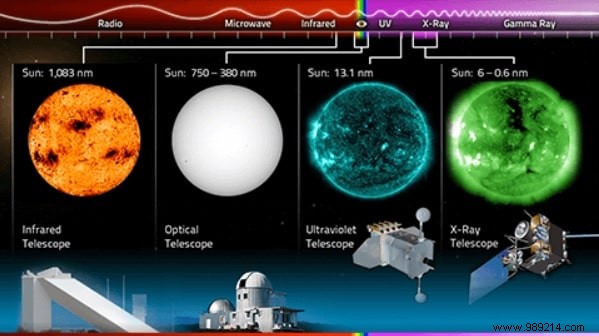At dawn, the Sun takes on orange colors; at the zenith, it often shines bright yellow; and at dusk it usually sports yellow-orange hues. It would be tempting then to think that the light that the Sun emits is naturally composed of wavelengths relative to yellow and orange. However, the physical reality behind sunlight is not so simple.
According to Christopher Baird, a physicist at West Texas A&M University, the entire Sun and all of its layers shine. The color of the Sun refers to the spectrum of colors present in its light, which results from a complex interplay of all parts of the star. If we are trying to determine what color the Sun is, we must study the Sun's rays on Earth and quantify them.
There are several ways to do this, and they are not particularly complex; most kids have probably done some version of this experiment, with a prism. Indeed, the spectral content of a beam of light can be easily identified by passing the beam through a prism.
These simple objects break down the beam of light into its various components of pure color. Each pure color has a distinct wavelength. This is why scientists tend to use the words "color" and "frequency" interchangeably, because the color of a ray of light is defined by its frequency — for visible light, red has the highest frequency. bass and violet has the highest frequency. The range of colors or frequencies in a beam of light is called a spectrum.
When we direct the sun's rays through a prism, we see all the colors of the rainbow coming out the other end. That is to say, we see all the colors visible to the human eye. Therefore, the Sun is white, because white is made up of all colors.

A slightly more sophisticated way to do this is to use a camera, which takes a quantitative measurement of the brightness of light hitting different pixels, and therefore gives us a way to plot the brightness of different frequencies in the solar spectrum. If a particular frequency were always brighter than one of the others, we could conclude that the Sun is a shade of that color, but it is not.
When physicists perform this experiment, they quantitatively find that all visible colors are present in sunlight in approximately equal amounts. Critically, however, these frequencies are not present in exactly the same amount, but the discrepancies are simply not large enough to be meaningful. Thus, the spectral components of sunlight are quantitatively so similar enough that it is far more correct to say the Sun is white than to say it is yellow, orange, or any other outright color.